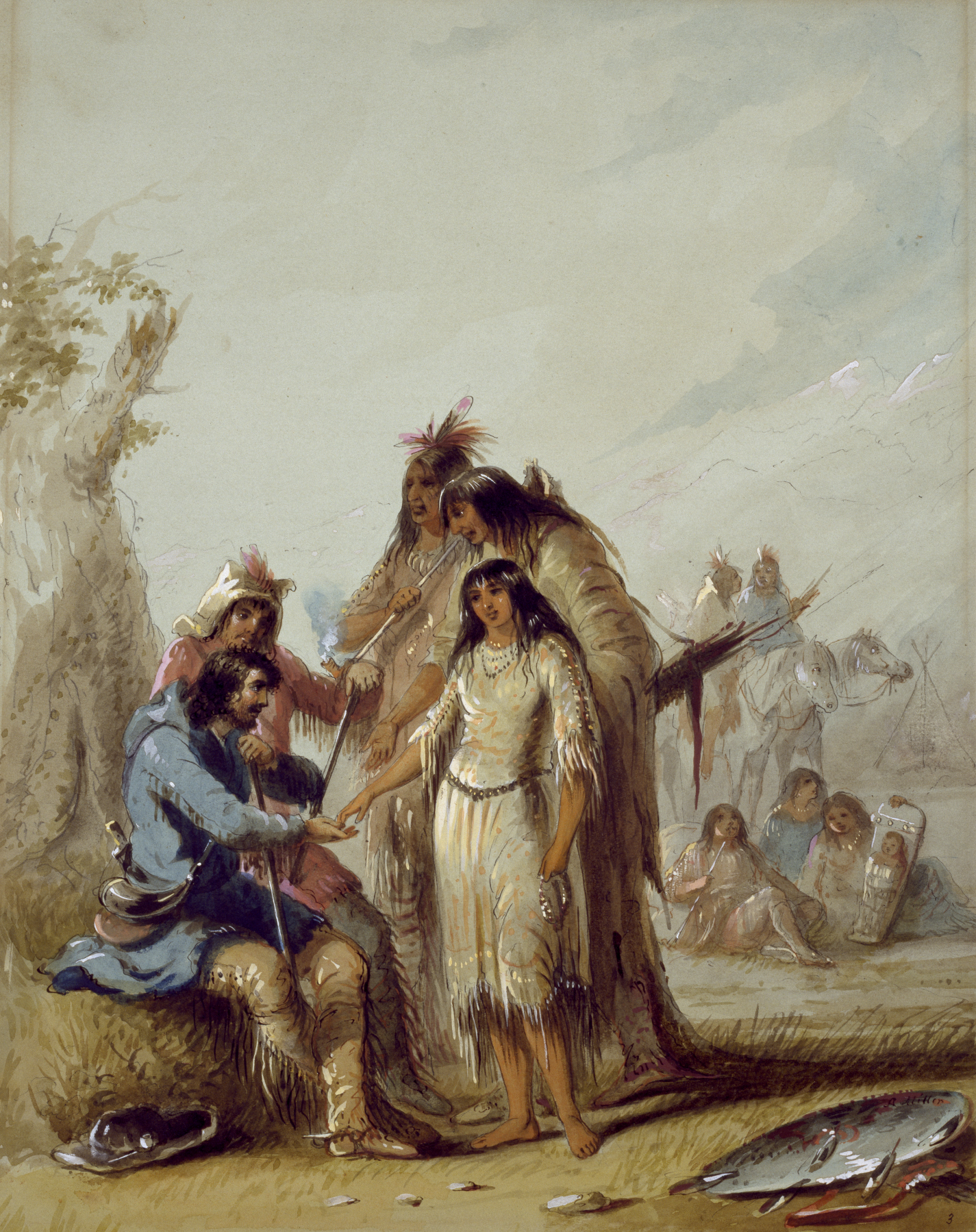The Trapper's Bride
(18th and 19th Centuries )
Extracts from Alfred Jacob Miller’s original text, which accompanied his images of Native Americans, are included below for reference. These words, which shaped how Miller’s contemporaries viewed the watercolors, reveal the racism and sexism embedded in 19th-century exploration and colonization of the western part of what is today the United States.
"The scene represents a Trapper taking a wife, or purchasing one. The prices varying in accordance with circumstance. He (the trapper) is seated with his friend, to the left of the sketch, his hand extended to his promised wife, supported by her father and accompanied by a chief, who holds the calumet, an article indispensable in all grand ceremonies. ... A Free Trapper (white or half-breed), being ton or upper circle, is a most desirable match, but it is conceded that he is a ruined man after such an investment, the lady running into unheard of extravagancies. She wants a dress, horse, gorgeous saddle, trappings, and the deuce knows what besides. For this the poor devil trapper sells himself, body and soul, to the Fur Company for a number of years. He traps beaver, hunts the Buffalo and bear, Elk and etc. The fur and robes of which the Company credit to his account." A.J. Miller, extracted from "The West of Alfred Jacob Miller" (1837).
In July 1858 William T. Walters commissioned 200 watercolors at twelve dollars apiece from Baltimore born artist Alfred Jacob Miller. These paintings were each accompanied by a descriptive text, and were delivered in installments over the next twenty-one months and ultimately were bound in three albums. Transcriptions of field-sketches drawn during the 1837 expedition that Miller had undertaken to the annual fur-trader's rendezvous in the Green River Valley (in what is now western Wyoming), these watercolors are a unique record of the closing years of the western fur trade.
Inscription
Provenance
Provenance (from the French provenir, 'to come from/forth') is the chronology of the ownership, custody, or location of a historical object. Learn more about provenance at the Walters.
William T. Walters, Baltimore, 1858-1859, by commission; Henry Walters, Baltimore, 1894, by inheritance; Walters Art Museum, 1931, by bequest.
Exhibitions
| 2001 | The American Artist as Painter and Draftsman. The Walters Art Museum, Baltimore. |
| 1989 | The Western Experience. The Monmouth Museum, Lincroft. |
| 1984 | Alfred Jacob Miller: Watercolors and Drawings. The Walters Art Gallery, Baltimore. |
Conservation
| Date | Description | Narrative |
|---|---|---|
| 4/3/1964 | Treatment | re-housed |
| 6/6/1984 | Treatment | mounted |
| 2/21/1989 | Loan Consideration | examined for loan |
| 3/10/1993 | Treatment | mounted |
Geographies
USA (Place of Origin)
Measurements
12 x 9 3/8 in. (30.5 x 23.8 cm)
Credit Line
Commissioned by William T. Walters, 1858-1860
Location in Museum
Not on view
Accession Number
In libraries, galleries, museums, and archives, an accession number is a unique identifier assigned to each object in the collection.
In libraries, galleries, museums, and archives, an accession number is a unique identifier assigned to each object in the collection.
37.1940.12



